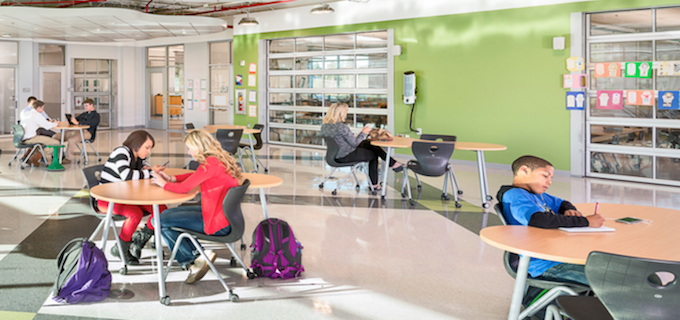Quiet, Please! Rethinking Our Learning Spaces
A MiddleWeb Blog
 In the summer while my sons are in camp, I spend a lot of quality time with my laptop in coffee shops. Amid the buzz, I work anonymous and undisturbed. While my iced coffee beads sweat, I go deep into the zone – writing, planning, researching, reading.
In the summer while my sons are in camp, I spend a lot of quality time with my laptop in coffee shops. Amid the buzz, I work anonymous and undisturbed. While my iced coffee beads sweat, I go deep into the zone – writing, planning, researching, reading.
If I didn’t teach all year, this kind of work could start to feel lonely, but for a month or so it hits the spot.
This summer I’ve been reading about effective learning spaces, in part to counteract a tendency to think in my head first, in physical space a distant second.
One theme has surprised me about these books – one that has nothing to do with modular furniture or wall displays.
Amid a near-universal celebration of collaborative, interactive work as a 21st century reality and ideal, a number of authors make a plea for something we so often forget in our classrooms and our schools: the need for quiet.
♦ In Redesigning Learning Spaces, Robert Dillon, Ben Gilpin, A.J. Juliani, and Erin Klein argue for “quiet seating options that support the needs of introverts throughout the day.”
♦ In Blueprint for Tomorrow: Redesigning Schools for Student-Centered Learning, Prakash Nair suggests several kinds of spaces from which students can benefit:
◊ Places to Be Alone – “These places do not have to be visibly private as long as students who occupy such areas feel that they are alone and undisturbed.”
◊ Places to Converse in Private with a Friend – These can take the form of “individual nooks” and “can also be used for a teacher to work one-on-one with a student who needs extra help or tutoring.”
◊ Places to Nourish the Mind and Spirit – Ideally, areas “connected with nature.” This kind of “restorative space allows for reflection and facilitates creativity.”
♦ And Rebecca Louise Hare and Robert Dillon observe in The Space: A Guide for Educators — “Quiet in our learning spaces allows us to slow down and allow life to happen, mistakes to play out, and for learning to happen more organically. Being intentional about quiet allows us to nurture a sustainable generation when it comes to stress.”

Looking at my classroom, I’m grateful every day that one wall consists of large windows facing a few trees. This adds calm to our space from the outset.
But what about inside?
Last year, inspired by lightweight student desks, I finally ditched rows as a default. Now I start class most days with two concentric semicircles, often moving into pods or pairs for group activities. This year, I think I’ll start with rows for the first week or so as I get to know students’ names, but we’ll soon after transition into the more relaxed arrangement that has made my students and me feel more conversational.

Fisher Middle School in Greenville SC, co-designed by Prakash Nair, includes both collaborative and solo student spaces. (Learn more)
What about places for students who need quiet away from the group, though? Such spots are nearly nonexistent, unless we’re doing research in the library.
This lack of private areas in schools is not unusual. As Susan Cain wrote in her bestselling Quiet: The Power of Introverts in a World That Can’t Stop Talking, “classroom desks are increasingly arranged in pods, the better to foster group learning, and research suggests that the vast majority of teachers believe that the ideal student is an extrovert” – even though, according to her research, “one third to one half of Americans are introverts.”
In Myers-Briggs tests over the years, although I’ve become more extroverted as I’ve gotten older, I always fall on the introverted side. I need time to recharge after a social gathering. I usually prefer one-on-one conversations to group small talk. And – right – I’m writing this article in a coffee shop, and I haven’t talked with anyone except the barista for several hours, and I’m quite happy.
So where is the place for kids like me, and kids more introverted than that, in school?
Thoughtful lesson plans can help. While facilitating projects or doing in-class activities, I frequently offer the chance to work alone or in a group. This approach – building time into class activities for quiet mental space – may be the best low-key solution to solitude in a school system that still gears itself toward constant interaction.

In history I don’t devote as much time to solo pursuits, and I miss it. Sometimes we do ten minutes of written reflection on a current event or an ethical question, and many students do look refreshed after the chance to sit alone with their thoughts. During research, silence occasionally settles in while students are reading and jotting notes, searching and thinking.
But I could do more to make the quieter as well as the louder students feel at home.
What do you do to create quiet spaces in your classroom amid the busy-ness and noise of school life?



































Sarah, the bestseller, “Quiet: The Power of Introverts in a World That Can’t Stop Talking,” made many of us aware of this need to think about the quiet student. Your thoughtful review gives teachers some specifics and more resources to help. Thanks!
Mary, this summer I’ve been rereading it, and I’m getting even more from the book than I did the first time. Thanks so much!
This is so important! In my middle school classroom, I work hard to make sure there are opportunities for students to find a quiet place to sit and work independently. We talk about it as a class and designate parts of the classroom as quiet spaces and other spots as team spaces. It’s not perfect, but it’s a beginning. Thank you for this important post!
Michelle, I enjoyed hearing about your classroom. What do the quiet spaces look like, and when do students tend to use them in the course of a period or a week?
Sarah, This is very interesting and thanks so much for sharing. Are there other books you are currently reading or have recently read that you would highly recommend for new teachers? I’ll be beginning my teaching career (9th grade world) in a few months and I want to read as much as possible. Thanks!
James – here’s an interesting article by a junior high teacher and intructional coach, Deanna Miller: Should We Be More Accommodating to Education’s Introverts?
James, there are so many books on different topics. This list of 50 is organized by theme and has some excellent ones, including The Passionate Teacher by Robert L. Fried and The Courage to Teach by Parker J. Palmer. http://www.topmastersineducation.com/50-best-books-for-new-teachers/
It’s not that you have become more extroverted as you grow older. It’s that you’ve developed coping mechanisms, as all introverts must do, to function in a world that believes extroversion is the norm.
Lisa, this is hilarious and makes my day. Thank you!